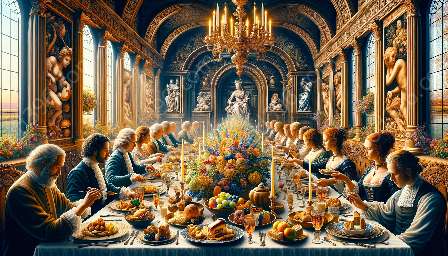Dining etiquette is more than just a set of rules – it is a reflection of the culture, tradition, and history of a society. Throughout history, dining etiquette has evolved alongside changes in food presentation and culinary practices, shaping the way people eat and dine. In this exploration, we will delve into the rich history of dining etiquette, its evolution, and the impact of food culture on these customs.
The Earliest Dining Customs
The history of dining etiquette can be traced back to ancient civilizations, where communal meals and rituals around food were an integral part of social and cultural life. In ancient Egypt, for example, dining was a significant event, and the way people ate and interacted during meals was governed by strict customs and social hierarchies. The same can be observed in ancient China and Greece, where dining etiquette was closely intertwined with religious beliefs and societal norms.
During the Middle Ages in Europe, dining etiquette became more elaborate and codified, with the emergence of formal dining rituals and complex table manners. The influence of religious practices and chivalric codes of behavior shaped the way people dined, emphasizing the importance of courtesy, hygiene, and proper conduct at the table.
The Renaissance and Enlightenment
The Renaissance and Enlightenment periods brought about significant changes in dining etiquette, as social gatherings and lavish banquets became a hallmark of the aristocracy and nobility. Table settings, dining utensils, and elaborate dining protocols signaled wealth, status, and refinement. The emergence of dining manuals and treatises on etiquette further solidified the importance of proper behavior and decorum at the table.
During this era, the art of food presentation also underwent a transformation, with an emphasis on elaborate table decorations, culinary craftsmanship, and the use of exotic ingredients. The evolution of food presentation became intertwined with dining etiquette, as the visual appeal of dishes and the arrangement of table settings became an essential part of the dining experience.
The Victorian Era and Industrial Revolution
The Victorian era marked a period of strict social codes and elaborate rituals, and dining etiquette reached new heights of complexity. The influence of the Industrial Revolution and the rise of the middle class led to a proliferation of dining customs and etiquettes that aimed to emulate the manners of the upper classes.
Dining became a performance, with an emphasis on elaborate table settings, formal dinners, and the strict observance of social niceties. The development of elaborate serving techniques and courses, such as the French service and Russian service, further shaped the way food was presented and consumed, marking a shift towards more refined and sophisticated dining practices.
The Modern Era and Global Influences
As we move into the modern era, the evolution of dining etiquette has been influenced by globalization, cultural exchange, and the fusion of culinary traditions. The rise of international travel and the spread of multicultural dining experiences have led to a blending of dining customs and etiquettes from different parts of the world.
Contemporary dining etiquette is a reflection of diverse cultural influences, with an emphasis on inclusivity, flexibility, and the celebration of culinary diversity. The evolution of food presentation has also taken on a modern twist, with the rise of innovative plating techniques, fusion cuisines, and the use of social media platforms to showcase dining experiences.
Conclusion
The history of dining etiquette is a testament to the ever-changing nature of food culture, societal norms, and human interaction. From ancient rituals to modern-day practices, dining etiquette has evolved and adapted to reflect the values and customs of different societies. By understanding the historical context and cultural influences that have shaped dining etiquette, we gain a deeper appreciation for the rituals, customs, and traditions that define the way we eat and dine.

